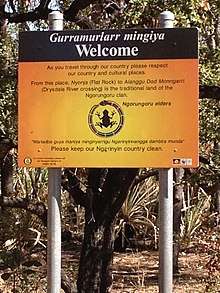Ngarinyin language
The Ngarinyin language (Ungarinjin), or Eastern Worrorran, is a moribund Australian Aboriginal language of Western Australia. With less than one hundred living speakers, Ngarinyin is considered a critically endangered language, though there are efforts being made to documenting speech and grammar structures before it becomes extinct, including the specifics on the terms of the kinship system of the language.
| Ngarinyin | |
|---|---|
| Eastern Worrorran | |
| Ungarinjin | |
| Region | Western Australia |
| Ethnicity | Ngarinjin, Wurla (Waladjangarri) |
Native speakers | 38 (2016 census)[1] plus 2 Andajin (2009)[2] |
Worrorran
| |
| Dialects |
|
| Latin | |
| Language codes | |
| ISO 639-3 | Either:ung – Ngarinyinajn – Andajin |
| Glottolog | ngar1284[3] |
| AIATSIS[2] | K18 Ungarinyin, K23 Andajin, K25 Munumburu, K26 Wolyamidi |
Classification
Ngarinyin is one of the Worrorran languages. It is a dialect cluster, and may be considered more than a single language; Bowern (2011) lists Ngarinyin, Andajin, and Worla.[4]

Usage
As a nearly extinct language, Ngarinyin is found only within the local region of Northern Kimberley, Australia, and other local languages are found in the surrounding region instead due to the small population of Ngarinyin speakers, including the Worrorran languages of Wunambal and Worora. Ngarinyin is found at the center of the region, and the other aboriginal languages in the area face similar levels of endangerment. Ngarinyin was previously one of the most prevalent of the aboriginal languages in Northern Kimberley, but it has since become a language known only by a small number of the elderly.[5] Kriol is often used by younger generations instead of Ngarinyin, though some knowledge of the language is still retained by these people.[6]
Kinship Terms
Ngarinyin places great emphasis on the classification of family members and is similar to the neighboring aboriginal languages of Worora and Wunambal to the point of being virtually identical, though it is still considered unusual among those that study kinship systems of aboriginal languages.[7] One of the most noticeable features of this system is the use of identical terms given to kin usually separated by generation level. For instance, the titles wife's brother, wife's father and wife's father's father in English all share the same title of waiingi in Ngarinyin.
Phonology
Notes
- "Census 2016, Language spoken at home by Sex (SA2+)". stat.data.abs.gov.au. ABS. Retrieved 30 October 2017.
- K18 Ungarinyin at the Australian Indigenous Languages Database, Australian Institute of Aboriginal and Torres Strait Islander Studies (see the info box for additional links)
- Hammarström, Harald; Forkel, Robert; Haspelmath, Martin, eds. (2017). "Ngarinyin". Glottolog 3.0. Jena, Germany: Max Planck Institute for the Science of Human History.
- Bowern, Claire. 2011. "How Many Languages Were Spoken in Australia?", Anggarrgoon: Australian languages on the web, December 23, 2011 (corrected February 6, 2012)
- Capell, Arthur (1 May 2017). "The Classification of Languages in North and North-West Australia". Oceania. 10 (3): 241–272. doi:10.1002/j.1834-4461.1940.tb00292.x. JSTOR 40327769.
- "Ngarinyin". Ethnologue. Retrieved 1 May 2017.
- Rumsey, Alan (1 January 1981). "Kinship and Context among the Ngarinyin". Oceania. 51 (3): 181–192. doi:10.1002/j.1834-4461.1981.tb01448.x. JSTOR 40332242.
References
- Capell, A. (1 January 1972). "The Languages of the Northern Kimberley, W. A.: Some Structural Principles". Oceania. 43 (1): 54–65. doi:10.1002/j.1834-4461.1972.tb01196.x. JSTOR 40330037.
- Coate, H. H. J.; Elkin, A. P. (1974). Ngarinjin-English Dictionary. Sydney: Oceania Linguistic Monographs.
- Coate, H. H. J.; Oates, Lynette (1970). A Grammar of Ngarinjin. Canberra: Australian Institute of Aboriginal Studies.
- Dixon, R. M. W. (2002). Australian Languages: Their Nature and Development. Cambridge: Cambridge University Press.
- McConvell, P., Keen, I., & Henderey, R. (2013). 7. The Evolution of Yolngu and Ngarinyin Kinship Terminologies. In, Kinship Systems: Change and Reconstruction (132). University of Utah Press.
- Rumsey, A. (1982). An intra-sentence grammar of Ungarinjin, north-western Australia. Canberra: Pacific Linguistics.
- Scheffler, H. W. (1 January 1984). "Meaning and Use in Ngarinyin Kin Classification". Oceania. 54 (4): 310–322. doi:10.1002/j.1834-4461.1984.tb02060.x. JSTOR 40330770.